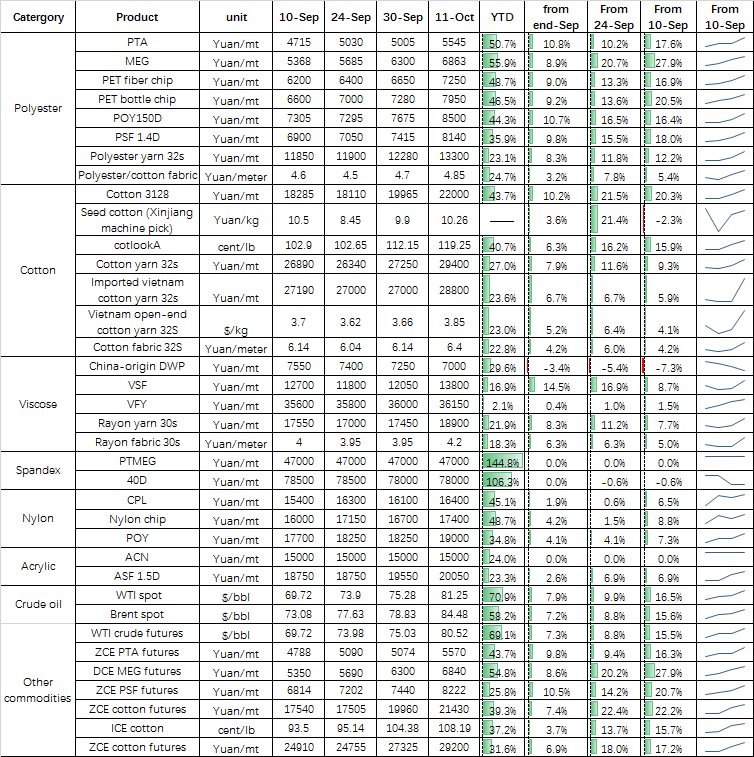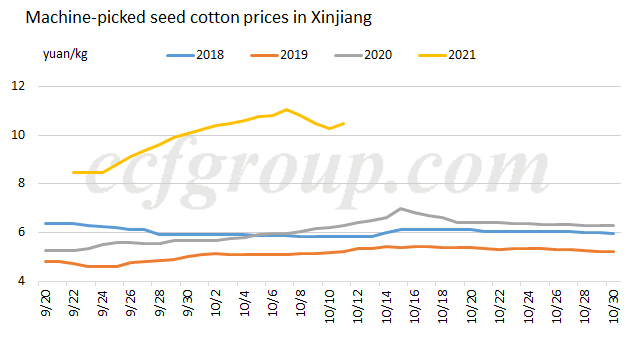Reasons behind the rise of cotton textile and chemical fiber industrial chain
The prices of cotton and synthetic fiber industry chain products have continued to rise since September 24. According to the data tracked by CCFGroup, as of October 11 , the polyester industry chain and the cotton industry chain rose the most. Meanwhile, some futures varieties rose more fiercely, especially ZCE cotton futures which rose 22.4% on October 11 compared with September 24.
From the perspective of the products, PTA and MEG at the raw material end of the polyester chain have increased significantly; in the cotton chain, domestic and foreign cotton prices have risen prominently, especially domestic cotton prices; in the viscose chain, viscose staple fiber has the largest increase, about 15%; relatively speaking, the price increase of acrylic fiber and nylon is much lower, both lower than 10%, and the price of spandex chain remains basically stable as the price has hit record high earlier.

Polyester industrial chain
Cost side pulled up polyester price largely. Firstly, global energy consumption increased sharply, providing strong impetus to chemical products. Secondly, under the dual control of energy consumption in China, the supply of PTA and MEG reduced. After National Day holiday, the prices of PTA and MEG both rose 500-600yuan/mt. Therefore, the costs of polyester feedstock surged.
The rise of PSF price was mainly bolstered by crude oil, as well as dual control on energy consumption and soaring cotton.
Surge of crude oil. The price of crude oil was pegged at about $75/bbl before National Day holiday, and rocketed to nearly $80/bbl during the holiday. Thus, direct-spun PSF plants raised offers by 300-400yuan/mt weighed by the high costs.
Dual control on energy consumption. Since Oct 4, electricity restriction started to be implemented in Changle, Fujian, and Jingwei and Shanli began to cut production, following Jinlun, Xianglu and Jinxing which had reduced production partly before. Currently, the operating rate of direct-spun PSF in Fujian was only around 62%. In Jiangsu, the operating rate of some major enterprises continued to move down.
Soaring cotton attracted market’s focus on substitution of PSF. As cotton price at home and abroad both rocketed, the producing costs increased sharply. With lower price, PSF triggered market participants’interest.
Cotton textile industrial chain
Cotton prices have started to rise in end Sep. Chinese cotton prices were mainly driven by higher seed cotton prices in Xinjiang due to the harvest-rush, and the rise of international cotton prices was partly due to the easing relations between China and the United States after the return of Meng Wanzhou, and partly due to the supply concerns caused by the rainfall in Texas and the hurricane in India. In addition, China began to purchase large quantity of U.S. cotton, supportive to ICE cotton. Under such condition, cotton yarn and cotton grey fabric prices had to follow up despite of unfavorable demand.

On the one hand, seed cotton prices in Xinjiang continued to rise, and have been much higher than previous years. The harvests kicked off since Sep 25, and the competition for seed cotton procurement was fierce with increase of ginning capacities this year. On Oct 1, the mainstream machine-picked seed cotton prices exceeded 10yuan/kg, and on Oct 8, the prices have reached 11yuan/kg. On the other hand, the concerns on the global supply aroused. The rainfall in the major cotton producing areas of U.S. was excessive, especially the rainfall in Texas, triggering the worries on supply. In addition, the Indian cotton production is supposed to be impacted by the pest infestation and Hurricane Gulab.
The rainfall in the global major cotton producing countries is far higher than the average level in recent years. By the week ending Oct 2, the average rainfall in the major cotton producing areas of U.S. was 1.1 inches, an increase of 0.26 inch from previous week. In Texas, the average rainfall was 1.86 inches, up 1.78 inches from previous week. Besides, rainfall in India was also higher than the normal level due to the Hurricane Gulab.
Cotton yarn and cotton grey fabric prices ticked up following the trend of cotton prices in face of higher spinning costs.
Viscose industrial chain
The reversal of VSF price at the end of Sep was mainly driven by rising cost resulting from continued rise of raw materials. VSF price hiked at the end of Sep because the operating rate of VSF plants declined amid short energy supply and continued increase of coal and caustic soda prices. The soaring cotton was also a driving force.
Spandex industrial chain
Price of spandex has increased by as high as 106% year to date and turned to shiver at high level after the National Day holiday as there will be 100kt/year of new units to be launched in Q4 while downstream buyers mainly purchase on a need-to-basis. Current spandex price has hit 13-year high, so most suppliers held price stable and some new units discounted price for promotion.
Nylon industrial chain
Nylon 6 textile filament prices were mainly pushed up by two reasons. First, upstream CPL and nylon 6 HS chip prices were driven up by the quickly rising benzene cost. Second, a large number of nylon filament plants had shut or cut production amid dual controls on energy consumption, filament makers were reluctant to sell at previous lows and some raised prices further to catch up with upstream cost rise.
Acrylic fiber
Acrylic fiber prices also ticked up. On the one hand, pricing right among the domestic acrylic fiber plants has concentrated gradually. Previously, the pricing right is mainly based on Sinopec and Jilin Chemical Fiber. Currently, part of units under Sinopec is withdrawing gradually, and Jilin Chemical Fiber has more pricing right. Besides, plants pay more attention to the profits this year, so producers have strong willingness to support prices. On the other hand, ACN prices remain high, leading to high costs for acrylic fiber, so acrylic fiber plants are hard to gain profits with the production cut and seek for the upswing of prices.
Generally, the market began to undergo a major change in the week before the National Day, and the cotton spinning and chemical fiber industry chains have shown price increases, especially polyester and cotton industry. Taken together, this round of price increases can be summarized into two factors, one is the cost concerns caused by the supply side, and the other is affected by the current domestic dual control policy. The further price increase is still related to government policy regulation and market demand.
- Top keywords
- Cotton Price
- Cotton Futures Price
- Cotton Futures
- CZCE
- PTA Futures Price
- Chemical Fiber
- Polyester Prices
- Wool price
- PTA Futures
- Shengze Silk
- China
- Yarn Price
- price
- China Textile City
- Fibre Price
- Benzene Price
- Cotton
- Index
- Cotton Index
- PTA
- fabric price
- NYMEX
- Top 10
- textile industry
- Spot Cotton
- Cotton Yarn
- Polyester Price
- Futures
- PTA Price
- cotton yarn price

